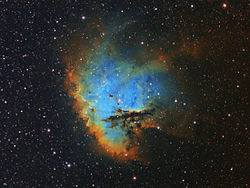NGC 281
| Emissionsnebel | ||
|---|---|---|
| Daten von NGC 281 | ||
 | ||
| Der Emissionsnebel NGC 281 aufgenommen von der Erde aus. Der helle Stern in der Mitte ist BD +55° 191 (HD 5005). | ||
(c) IAU and Sky & Telescope magazine (Roger Sinnott & Rick Fienberg), CC BY 3.0 | ||
| AladinLite | ||
| Sternbild | Kassiopeia | |
| Position Äquinoktium: J2000.0, Epoche: J2000.0 | ||
| Rektaszension | 00h 52m 25s [1] | |
| Deklination | +56° 34′ [1] | |
| Erscheinungsbild | ||
| Winkelausdehnung | 35' × 30'[2] | |
| Ionisierende Quelle | ||
| Bezeichnung | IC 1590, BD +55° 191 (HD 5005) | |
| Typ | Sternhaufen mit Stern der Spektralklasse O5.5 | |
| Physikalische Daten | ||
| Zugehörigkeit | Milchstraße | |
| Entfernung | 9500 Lj | |
| Geschichte | ||
| Entdeckung | E. E. Barnard | |
| Datum der Entdeckung | 16. November 1881[3] | |
| Katalogbezeichnungen | ||
| NGC 281 • IC 11 • LBN 616 • Ced 3 | ||
NGC 281 ist ein Emissionsnebel im Sternbild Kassiopeia am Nordsternhimmel, der 9500 Lichtjahre von der Erde entfernt ist. Der Nebel ist im Index-Katalog als IC 11 erfasst und wird umgangssprachlich wegen seiner Ähnlichkeit mit der bekannten gleichnamigen Videospiel-Hauptfigur vor allem im englischen Sprachraum auch als Pac-Man-Nebel bezeichnet. In NGC 281 ist der offene Sternhaufen IC 1590 eingebettet, dessen Sterne um das Zentrum des Nebels verstreut sind und von denen einige durch ihre Röntgenstrahlung hervortreten. Das hellste Mitglied von IC 1590, das Mehrfachsternsystem BD +55° 191 (HD 5005), ist die ionisierende Quelle des Nebels. Der Nebel enthält auch mehrere Bok-Globulen, in denen durch Infrarotaufnahmen Anzeichen für Sternentstehung festgestellt werden konnten. Ebenfalls in Infrarotaufnahmen ist die Molekülwolke erkennbar, deren ionisierter Teil der Emissionsnebel ist.
NGC 281 wurde am 16. November 1881 vom US-amerikanischen Astronomen Edward Emerson Barnard entdeckt.
- Nahaufnahme einer Bok-Globule in NGC 281 (Hubble-Weltraumteleskop)
- Die Röntgenstrahlung des eingebetteten Clusters IC 1590 ist in der Aufnahme des Röntgenteleskops Chandra violett zu sehen.
- Die Aufnahme des Wide-Field Infrared Survey Explorers zeigt die Molekülwolke, deren ionisierter Teil als Emissionsnebel (blau, links oberhalb der Bildmitte) zu sehen ist.
Weblinks
- Arcade adventure for young stars (engl.)
- Porträt von NGC 281 – Astronomy Picture of the Day vom 10. Dezember 2008.
- NGC 281: The Pacman Nebula – Astronomy Picture of the Day vom 23. August 2005 (englisch).
- NGC 281: Cluster, Clouds, and Globules – Astronomy Picture of the Day vom 7. April 2003 (englisch).
- Spektrum.de: Sammlung von Amateuraufnahmen
- SIMBAD Query
- NASA/IPAC Extragalactic Database
Einzelnachweise
Auf dieser Seite verwendete Medien
NGC 281 is a bustling hub of star formation about 10,000 light years away. This composite image of optical and X-ray emission includes regions where new stars are forming and older regions containing stars about 3 million years old.
The optical data (seen in red, orange, and yellow) show a small open cluster of stars, large lanes of obscuring gas and dust, and dense knots where stars may still be forming. The X-ray data (purple), based on a Chandra observation lasting more than a day, shows a different view. More than 300 individual X-ray sources are seen, most of them associated with IC 1590, the central cluster. The edge-on aspect of NGC 281 allows scientists to study the effects of powerful X-rays on the gas in the region, the raw material for star formation.
A second group of X-ray sources is seen on either side of a dense molecular cloud, known as NGC 281 West, a cool cloud of dust grains and gas, much of which is in the form of molecules. The bulk of the sources around the molecular cloud are coincident with emission from polycyclic aromatic hydrocarbons, a family of organic molecules containing carbon and hydrogen. There also appears to be cool diffuse gas associated with IC 1590 that extends toward NGC 281 West. The X-ray spectrum of this region shows that the gas is a few million degrees and contains significant amounts of magnesium, sulfur and silicon. The presence of these elements suggests that supernova recently went off in that area.Opaque red circle
Autor/Urheber: Hewholooks, Lizenz: CC BY-SA 3.0
NGC281 - Pacman Nebula in Hubble Palette Narrowband from amateur equipment
Autor/Urheber: Judy Schmidt from Fresh Meadows, NY, USA, Lizenz: CC BY 2.0
More infrared astronomy from WISE. Once again, I've reversed the wavelength order for what I consider a more aesthetically pleasing result, so keep in mind that deep blue is the longer wavelength and red is the shorter wavelength.
The Pacman Nebula, otherwise known as NGC 281, is revealed not as a singular pool of light but as a larger structure of seemingly related knots and trails of dust. Pacman itself is the largest blue structure northeast of center. The two other noticeable structures do not have any special designations.
In the lower right corner of the image is a blueish strand of stars I included because it seemed interesting. Deep blue in this case corresponds to the warm dust in the 22 micron channel. In visible light, a knot of dark, obscuring dust is visible in the location of the strand, but no stars are. If I had to guess I would say they stars in the process of forming. They just happen to be in a line like this instead of clustered into more of a blob. I couldn't find any literature on this particular structure, but star forming regions are ubiquitous throughout the Milky Way. What does seem unusual is their isolation and apparently long, linear shape. I haven't spent nearly enough time studying infrared imagery to say whether it is common or uncommon, though. Is this what a stellar nursery looks like before they begin to blow away their natal dust cloud?
I tried very hard to balance the colors this time and not have the blue and red overwhelm the image, so more cyan is showing through this time, unlike with the Pleiades image. Nine WISE frames were aligned and matched to create a smooth mosaic. Some small optical artifacts were removed. No sharpening or color saturation was done.
Red: W1 (3.4 μm) Yellow-Green: W2 (4.6 μm) Cyan: W3 (12 μm) Blue: W4 (22 μm)
North is up.(c) IAU and Sky & Telescope magazine (Roger Sinnott & Rick Fienberg), CC BY 3.0
IAU Cassiopeia chart.









